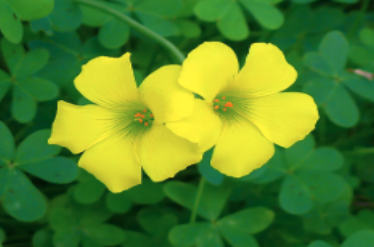Sourgrass Oxalis Stricta
Sourgrass, beloved by children (and some adults too!), but despised by gardeners. This plant (some might say weed) has bright, almost highlighter yellow 5-petaled flowers. I have a yellow pencil skirt in a similar color. I like to wear it on gray, rainy days to contrast, just like the yellow blossoms contrast to the dark green leaves. Their clover-like leaves have a faint lemony taste, but as many a child can tell you, the most flavourful part is the stem. With its deliciously acidic taste, it is a welcome sight on a walk through the neighborhood. However, it is a weed that uses up valued nutrients and spreads quickly, so most gardeners dislike them.
Sourgrass gets its sour flavour from the oxalic acid, but they are actually quite healthy for you. They are high in vitamin c and antioxidants, and they also can help treat scurvy, stomachaches, and fevers. However, oxalic acid is dangerous for people with kidney problems. Sourgrass’ scientific name, Oxalis, comes from the oxalic acid. The root word for oxalis comes from the Greek word oxys, meaning "sharp” or "sour".
Sourgrass grows primarily in California, but it originally came from southern Africa. It is also perennial [grows during all times of the year], but it dies out when the climate is too hot, cold, or dry. However, it will spring back at the next open opportunity. In San Francisco, it usually grows during spring. I always hear “Do not eat the ones that grow down low, a dog could have peed on them.” This is sad, because they tend to grow close to trees, in parks, or in other plant-filled ground level spaces. On the rare occasion one grows up high, I tend to savor it. If you want some but can’t find any up high, then take some home and wash it thoroughly and then enjoy!
One time I was rollerblading and I fell down ( I am not that good yet) and I saw some of the blooms smiling up at me like tiny suns on earth. I picked two stems (one for me and one for my sister). I squeezed out the super sour, acidic, tart but not bitter juice, regalling in the tangy flavour. Those were the first blooms that year, heralding the arrival of hundreds of these flowers filling up green spaces (and sidewalk cracks). I hope you have a marvelous time enjoying these sour plants, but do not eat too much, as oxalic acid can be dangerous in large quantities. And if you are a gardener who deals with them, pull out the flower’s roots to stop them from spreading.
